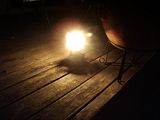GPS, geocaching
homebrewing
KF5RCA
Scanning
Ford Ranger
Preparedness
Coleman gear
Highland Terrace
Team Mousetrap
Resume
I recommend...


Get Linux!






[
preparation homepage |
72hr kit |
B.O.B. |
water |
everyday preparedness |
Coleman stoves and lanterns |
which SHTF stove? |
Preparedness simulations/scenarios |
kerosene lanterns |
canning
frs/gmrs radio
]
"You don't save grasshoppers by feeding them when winter comes;
you save grasshoppers by turning them into ants." -- Jack Spirko.
"When grasshoppers get hungry they turn into locusts." -- LdMorgan

I'll try to present each technology objectively. Pay special attention to the fuel columns.
| Stove | Fuel | cost of stove | weight of stove | cost of fuel | low-temp performance | ease of use | best for | worst for |
| "Sportster" style:
Coleman 550B multifuel, 533 dual fuel. |
coleman fuel or unleaded, kero on some | medium, ~$50 | heavy, ~32oz | low | good | requires full attention | hiking, BOB, feeding 1-2 people | ultralight backpacking, feeding more than 2 people |
| Euro self-pressurizing:
Svea 123 series vertical stove, Optimus 8R/111 lunchbox stoves. |
coleman fuel or unleaded | high, ~$80 | medium ~19oz | low | good, but requires priming | requires full attention and willingness to perform pleasant rituals | camping, feeding 1-2 people. Simplicity and durability. | ultralight backpacking, feeding more than 2 people. Parts availability |
| Skeleton-type liquid fuel:
MSR Whisperlite Intl, Whisperlite, Dragonfly. | coleman fuel | high, $80+ | medium, 16oz | low | good | requires attention | expeditions | abusive users, need to simmer |
| Minimalist screw-on-canister:
MSR Pocket Rocket, Superfly. Brunton Raptor, Talon. Coleman F1. |
butane, isobutane, or propane | medium, $50 | very low, 2-4oz | very high | poor | very easy | ultralight packing, minimal cooking | campsite or other heavy use cooking |
| Suitcase stove
Coleman 424 two-burner dual fuel |
coleman, unleaded | high, $100 | very heavy, 160oz (!) | low | good | requires attention | family cookouts, campsite cooking, heavy cooking. Permanent cooktop. | backpacking |
| Suitcase stove, propane
Coleman InstaStart PerfectFlow. |
propane | high, $60 | heavy, 160oz | medium | good | very easy | tailgating, medium cooking | backpacking, heavy cooking |
| Esbit | esbit tablets, triox | very low, $4 | very light, 3oz | high | good | very easy | BOB, survival cooking or water heating | windy conditions, anything more than very light cooking |
| Alcohol stoves:
Trangia basic, minitrangia. Liberty Mountain Westwind. Vargo Triad. Home-made penny, altoids stoves. |
ethanol (denatured or everclear), methanol for jetted stoves. 70% Isopropyl not practical. | free to low ($20) | ultralight 1oz to medium | medium-high | poor; boiling points 147F (methanol) - 172F (ethanol) | easy to use, may require assembly | ultralight packing, roadside scavenging, silent cooking, dark cooking (blue flames generally) | camping, more than light cooking |
| traditional fire | wood,other combustibles | Generally free. Can cook in open, or make billy can | none to minimal | free | good if tended | easy to keep going; can be hard for the untrained to start fire. | long term situations in wooded areas, soothing to onlookers. | windy conditions, treeless or picked-over areas. Areas where you don't want visible flame. |
| Stove | Fuel | cost of stove | weight of stove | cost of fuel | low-temp performance | ease of use | best for | worst for |
Why not propane or other compressed gas solutions? Here are my excuses for not going propane ("profane") even though the market is definitely headed that way:
BTU per $1 spent for fuel 45,658 - unleaded by the gallon 18,200 - coleman fuel by the gallon 16,483 - propane in 20# canisters (up to 20,000 with a good fill and aggressive price) 7,912 - propane in 1# canisters 4,125 - SLX denatured alcohol (apparently denatured with 50% methanol) 3,562 - methanol (HEET) 2,787 - generic butane canisters, generally 8oz 1,945 - isobutane canisters (MSR, JetBoil, etc in larger canisters) 837 - ethanol (everclear) 722 - hiking butane/isopropane canisters (ie, powermax) 618 - Coughlin's hexamine (like esbit, just less $$$) 450 - esbit (yellow flame, sticky, nontoxic) 337 - triox (tactical blue flame, not sticky, toxic)and by the pound:
21656 - propane 21165 - butane 18500 - coleman fuel 14220 - isopropyl (~90%, but difficult to use cleanly in stoves) 12926 - esbit / hexamine 12764 - ethanol 9755 - methanol
CallingMart.com. Discounted wireless refills. Instant PIN delivery.